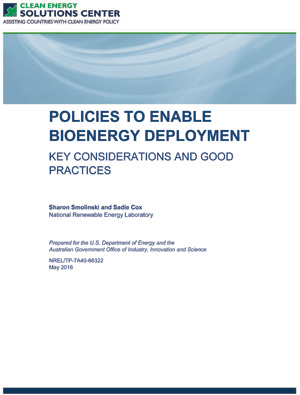Policies to Enable Bioenergy Deployment

The Solutions Center’s Policies to Enable Bioenergy Deployment: Key Considerations and Good Practices is part of the Solutions Center’s Clean Energy Policy Briefs series.
Bioenergy is renewable energy generated from biological source materials, and includes electricity, transportation fuels and heating. Source materials are varied types of biomass, including food crops such as corn and sugarcane, non-edible lignocellulosic materials such as agricultural and forestry waste and dedicated crops, and municipal and livestock wastes. Fuels produced from the conversion of these materials include biodiesel and bioethanol liquid biofuels, and biogases. Some solid fuels can be used following relatively little processing, demonstrated by the direct combustion of densified wood chips. These varied fuels can be utilized alone or in conjunction with conventional fossil fuels, as in blends of bioethanol with gasoline, and the co-firing of wood and coal. Furthermore, fuels can be applied towards multiple end uses, including from within shared facilities which can co-generate electricity and heat. In these ways, bioenergy allows for diverse end uses from a variety of biologically based sources and fuel types.
While renewable electricity generation includes contributions from solar photovoltaic, wind, and hydropower technologies, an increasing amount of generation is supplied by biopower generated from biomass (REN21 2015; Pacini et al. 2014). In 2014, global biopower capacity increased to 93 gigawatts (GW), with 433 terawatt-hours (TWh) generated (REN21 2015). In the transportation sector, most renewable fuels are liquid biofuels, although the use of biogases is increasing (REN21 2015). Global annual biofuel production increased in 2014 to 94 billion liters of bioethanol and 29.7 billion liters of biodiesel, both led by the United States and Brazil (REN21 2015). There is increased trade in liquid biofuels, involving developed and developing countries, and including activity beyond regions of production (UNCTAD 2014). While the primary market for liquid biofuels continues to be road vehicles, newer markets include aviation and other transportation sectors (REN21 2015; Souza et al. 2015a; Pacini et al. 2014). In addition, bioenergy accounts for most of the heating provided by renewable energy sources, which collectively supplied 8% of the global consumption of heat in 2014 (REN21 2015). Bioenergy, across all of its subcategories, supported an estimated 3 million jobs in 2014 (Ferroukhi et al. 2015).
Policies that support bioenergy deployment generally align with goals that include mitigation of climate change, increased economic development, improved access to energy, and increased energy security (Acosta et al. 2015; REN21 2015; Pacini et al. 2014).
While bioenergy capacity and generation have increased, several barriers to deployment exist, including:
- Use of edible food crops for biofuels raises significant concerns over impacts to food security (Acosta et al. 2015; REN21 2015).
- Demand for biomass, both edible crops and (non-edible) lignocellulosic feedstocks, can impact land utilization and ecosystem stability (Acosta et al. 2015; REN21 2015).
- Determination of greenhouse gas (GHG) emissions from bioenergy would benefit from improved and consistent methodologies for life cycle analysis and land use changes (Macedo et al. 2015).
- Subsidies for traditional fuels and nuclear power limit cost competitiveness (REN21 2015).
- Uncertainty and sudden significant changes in policy hinder deployment (REN21 2015).
- Infrastructure and regulation is designed for single fuel deployment (REN21 2015).
- Policy development for the heating and cooling sector, including mandates for bioenergy in buildings, is insufficient (REN21 2015).
Key aspects of policies for bioenergy deployment are presented here as part of the Clean Energy Solutions Center’s Clean Energy Policy Brief Series. The policies presented specifically or broadly cover electricity generation, transportation, and heating. Policymakers can adapt these practices in the design of country-specific bioenergy policies.
Policies and Good Practices
The following summarizes the good practices and considerations for the design and implementation of bioenergy policies that are presented in this paper.
Renewable Electricity Standards
- Designing mechanisms to measure and track biopower
- Enforcing non-compliance penalties
- Limiting costs of compliance
- Designing long-term contracts
- Designing provisions for combined hear and power (CHP)
Feed-in Tariffs (FITs)
- Differentiating FIT payments based on technology and fuel type
- Differentiating FIT payments based on project size
- Designing long-term contracts and guaranteeing grid access
Biofuel Standards (Transportation)
- Developing and implementing complementary policies
- Designing flexible mandates
- Increasing mandates for lignocellulosic biofuels
District Heating Networks
- Considering diverse applications and fuel sources
- Financing new infrastructure over the long term
- Designing for the mandatory participation of consumers
- Applying taxation strategies and financial incentives supportive of biomass usage
- Considering local context in network design
Carbon Tax
- Designing a flexible carbon tax rate to achieve emissions target
- Focusing on upstream producers to reduce implementation costs
Sustainability Standards and Certification
- Aligning national and international standards
- Developing and applying technical capacity
Broad Recommendations
- Integrating bioenergy policies with water, land, and agricultural policies
- Integrating multiple energy sources and technologies in comprehensive policies
- Assisting developing countries
See Also
Bioenergy Policies in Action
The following country examples provide real-world experiences and lessons learned from developing and implementing policies for enabling bioenergy.
- Arizona (U.S.): CHP-Inclusive RES Policy in Arizona
- Kenya: FIT Policy Design in Kenya
- Thailand: Complementary Biofuel Policies in Thailand
- Denmark: District Heating in Denmark
- Sweden: Flexible Carbon Tax Policy in Sweden
- European Commission: Sustainability Criteria and Measurement Strategies Developed by the European Commission
